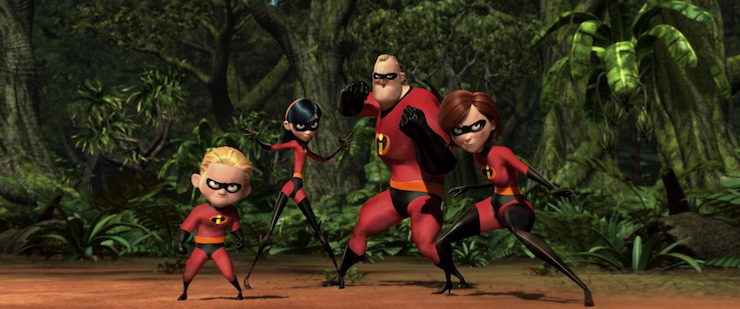After five massively successful films, John Lasseter thought it was about time to try something different. First, for once Pixar would create a film that would focus on humans instead of toys, bugs, monsters or fish. Superpowered humans, to keep things interesting. And second, instead of hiring a director from within Pixar’s ranks, he would hire an outsider, one of his former classmates, Brad Bird.
By 2000, director Brad Bird could have served as the poster child for broken dreams in Hollywood. Again and again he had seen projects approved by Hollywood executives, only to have those approvals rescinded by Hollywood executives—often the exact same Hollywood executives. In 1995 he thought he finally had his break, when Warner Bros hired him to direct the animated feature The Iron Giant. The film, released in 1999, received nearly universal critical praise, but bombed at the box office, earning only $31.3 million against a reported $80 million budget (less than the rival Disney, Pixar and upcoming Dreamworks pictures produced at the same time). Bird figured his career was over.
Until he reconnected with John Lasseter.
Bird wanted a movie that would, at its heart, reflect his current status as a middle-aged Hollywood screenwriter who had reached the point of doubting all of his life choices so far. Pixar wanted a movie that would, on its surface, make people laugh—and sell tickets. It all came together in The Incredibles.
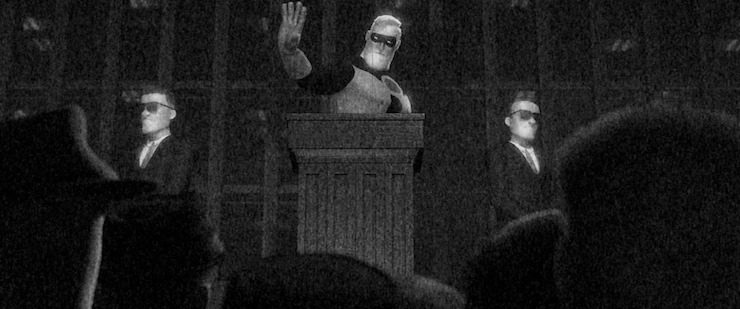
The Incredibles tells the story of what happens after the happily-ever-after. Spoiler: Reality ensues. After saving people (and a cat) one last time, Bob Parr, aka superhero Mr. Incredible, marries the love of his life, Helen, aka Elastigal. Awww. Except for the part where they start arguing right during the wedding ceremony, since saving people one last time almost made Bob late to his own wedding. They also almost immediately get sued by various people upset about all the damage incidentally caused by superheroes. Public reaction—shown in some beautifully animated moments designed to look like old newsreels—reaches the point where all superheroes, including newlyweds Mr. and Mrs. Incredible, need to be forcibly retired and hidden in witness protection programs for their own safety, not to mention government finances.
Fast forward a few years, to Bob Parr now working an insurance job. He’s miserable. Partly because he’s stuck at a boring desk job which has nothing to do with his skills and talents. (I feel much of the adult audience can relate.) Partly because he can’t help trying to help people—not an advantage when working for a company eager to NOT pay out premiums. Not surprisingly, he spends his free time looking at treasured objects—including his supersuit—from his past, and going “bowling” once a week with an old superhero friend. By “bowling” what I really mean is “risk his life again to try to stop crime to give some meaning back in his life.” This infuriates his wife, who wants him to focus on his family. Largely because his family is also having more than a few issues: two of the kids have superpowers, and although Violet just wants to be normal, Dash has been known to use his powers to torment teachers, and resents that he can’t join any sports teams because that might give away his superpowers.
Naturally, when a message arrives that will self-destruct (and does) right after he hears it play, Bob is eager to come on board, no matter what the warning signs—or the potential impact on his marriage and kids.
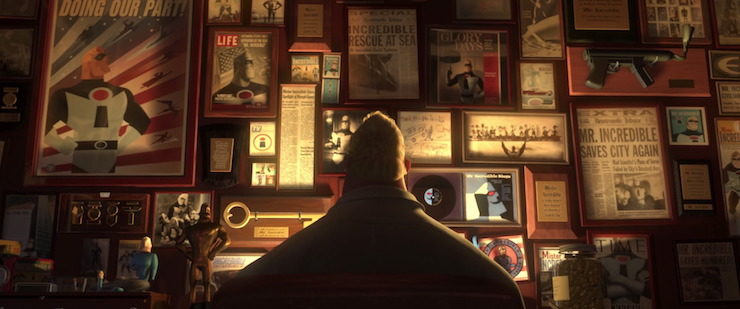
Bird claimed that he had no particular superheroes in mind when he created his early sketches for The Incredibles, but none of them sport particularly unique superpowers. Mr. Incredible’s superstrength and near invulnerability are classic traits of the various superhero team Strong Guys. A point I bring up since he slightly reminds me of Marvel’s Strong Guy, although the characters have very different personalities. Elastigirl’s stretching abilities are remarkably similar to those of Plastic Man and the Fantastic Four’s Mister Fantastic. Their daughter Violet’s ability to turn invisible and create force fields are even more remarkably similar to the abilities of the Fantastic Four’s Sue Storm, while son Dash has the superspeed of various Flashes and Quicksilver. Frozone makes ice slides that look suspiciously like the ones created by Iceman in various comics and cartoons, and another character looks even more suspiciously like a very dead Cyclops. Fortunately, the Incredibles have five family members, not four, or I’d be even more suspicious. The creators of the 2005 Fantastic Four film were suspicious enough—or alarmed enough—to make a few changes to their film to ensure that they wouldn’t be accused of copying in the other direction.
Standard superpowers aside, this is as much of a James Bond spy film as it is a superhero film. To match its 1960s look and feel, The Incredibles provides a near perfect Bond villain, complete with plans to Take Over the World, an Over the Top Lair, and even a Sexy Bond Girl. (It helps that Michael Giacchino’s score often sounds quite a bit like a James Bond score.) Sexy Bond Girl’s name is Mirage, and she adds another tinge to a surprising subplot of The Incredibles—Helen’s fear that Bob is having an affair. After all, quite a few of the signs are there: Bob’s various lies, his sudden improvement in his mood, his decision to start working out more… It doesn’t help when Helen finds Bob and Mirage sharing a platonic hug. It does help when—spoiler—Bob’s reaction to all of this is to give Helen a major kiss. The kiss is mostly borne of relief, but still, Bob’s entire body language could not be clearer: he’s interested in Helen, not the bombshell who has just released him from his chains.
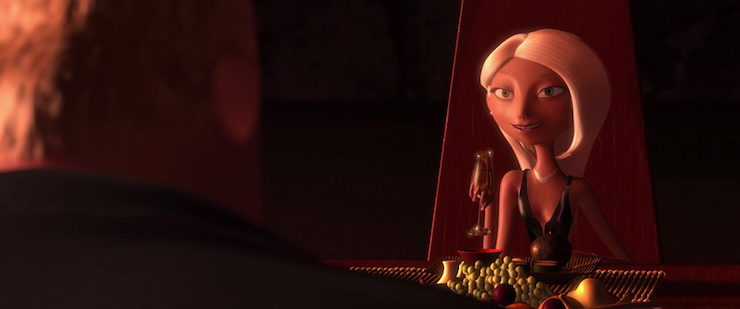
Which makes this also a film about marriage and trust and middle-age and fulfillment, all unusual themes for a children’s film, but all themes that by this time fit the Pixar style, which had previously explored questions of identity, loss, and parenting.
The Incredibles also took the time to explore many of the potential issues with being a superhero in real life, in both small things (if you have superstrength, you’re just a little more likely to break a plate while trying to cut through meat, and also, you might just be able to dent your cheap car with your fingers, a particular problem when you’re trying to hide your superpowers) and big ones: how to keep your secret identity after you’ve thrown your boss through several walls. The highlight of this is arguably the justly famous “NO CAPES” scene (I can’t help but think that Superman could have survived all of the examples Edna Mode lists, but then again, he’s Superman), but the film is littered with smaller and larger examples, most hilarious.
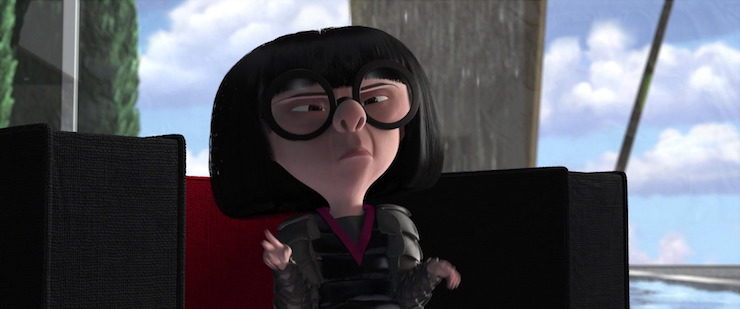
And also, a look at the other side: what is it like to live in a world where some people have superpowers, and you don’t? For Bob Parr’s boss, it means spending what looks like several weeks in traction. For a young neighbor kid, it’s the chance to see something awesomely cool. For Bob Parr’s lawyer, it’s a lot of paperwork. And for a young fan, it’s something much more: a desperate desire to be a superhero, to gain that sort of adulation. To be, well, special.
When that fails, the young fan angrily decides to come up with a new plan: to (eventually) release his superpowered gadgets to the world, allowing everyone to become a superhero. Once everyone is special, he claims, no one will be special.
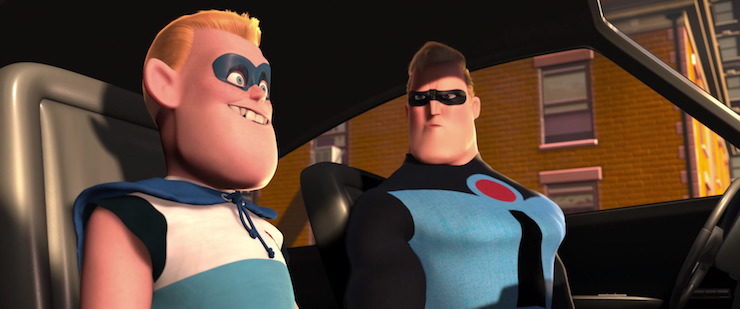
I think, however, the film disagrees with this point. Not just because—SPOILER—this is the sort of film where of course the good guys win, defeating the young fan’s plan, or because the speech is made by one of the bad guys, or even the negative way The Incredibles treats Bob Parr’s job at the insurance company: a place filled with identical cubicles, where no one is encouraged to be special or give clients special treatment. But rather because, in the world of The Incredibles, happiness comes only after people embrace the extraordinary: whether this is Bob returning to superhero work, or Violet embracing her powers, or even Edna Mode delighting in her return to her true love, superhero costume design, The Incredibles is all about finding happiness through embracing what makes you different. Even if you still need to conceal those differences every once in awhile—or agree to come in only second place in track.
But for most viewers, I think, The Incredibles works not because of any of these deep issues, but because it’s just plain fun—particularly the second half, which switches from an introspective yet funny meditation on middle aged life and the need for superheroes to a fast paced action film that uses the characters’ superpowers in often surprisingly entertaining ways—for instance, the way Elastigirl manages to create a speedboat in the open ocean. It’s great.
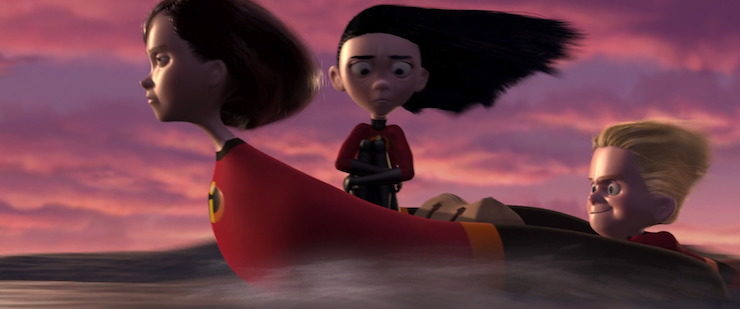
Also great: the vocal work. For this, Pixar hired the usual mix of well-known if not exactly the first person you’d think of for the part actors—comedian Craig T. Nelson, then and now best known for his non-superhero role on Coach, and Holly Hunter, known primarily for her work in drama and comedy, not action films, along with well-known and definitely someone you’d think of for the part—Samuel L. Jackson, playing, as always, SAMUEL L. JACKSON, and Wallace Shawn, channeling his inner Vizzini as he demands more competence from his employees, which for him means no longer helping customers. Various Pixar employees filled in for various bit parts, with Brad Bird taking on the voice of stylish and commanding Edna Mode, one of the highlights of the film.
The Incredibles also benefited from another major advance in computer animation: subsurface scattering, computer coding that allowed the computerized image to reflect light the way actual human skin does—that is, with some light entering the skin, and some bouncing back, or scattering. Here, as with Finding Nemo, the animators had to take care not to overdo things: computer-created images of people that look nearly human can cause a feeling of revulsion in actual human viewers, one of the major reasons all of the characters in The Incredibles were drawn with exaggerated features. But exaggerated features covered with nearly-human looking skin, another remarkable step forward in computer animation.
On top of that, Bird’s script required multiple special effects shots—particularly in the multiple sequences focusing on volcanoes and fire, but also, several explosions and brief underwater scenes, the latter greatly helped by Pixar’s recent experiences with Finding Nemo. Fortunately, by this point, Pixar had invested in more and faster computer processors. Tricky though all this was, The Incredibles managed to mostly avoid the last minute panic and overtime that had marked most of the previous Pixar films.
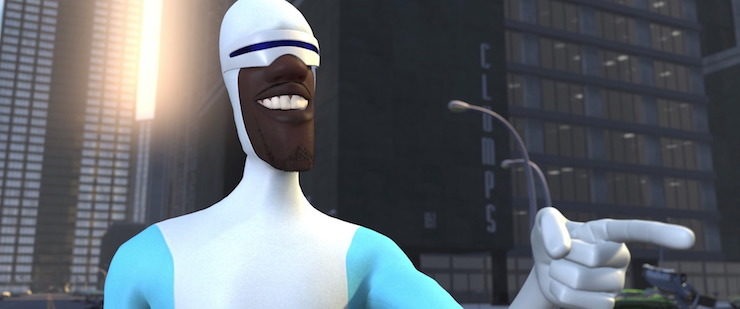
The Incredibles did well at the box office, pulling in a more than respectable $633 million—less than the $940.3 eventually brought in by Finding Nemo, and less than the $919.8 million brought in by another animated film released in 2004, Shrek 2, but still well above the box office takes for Disney’s more recent films—something Disney executives noted with alarm. The film also did very well with critics, landing on several top ten lists. It won the Academy Award for Best Animated Feature and a Hugo Award for Best Dramatic Presentation, Long Form. Disney released the usual merchandise, careful to use the name “Mrs. Incredible” instead of “Elastigirl,” to avoid confusion with a DC comics character. I refuse to confirm or deny whether or not I have two little Lego figures of The Incredibles characters standing right next to Lego Stitch in my home, but I will confirm that Disney ensured that I could. Disney also licensed a short lived comic book, and a theatrical sequel is currently in production for a 2018 release.
On the surface, everything looked great—so great that Brad Bird was almost immediately hired to direct another Pixar film, this one about a rat. But behind the surface, Pixar executives were considerably less happy. From their viewpoint, Disney was profiting wildly from their films, while providing very little in return—not to mention stretching the original Pixar/Disney deal into more films than Pixar had planned on. It was time, Pixar executive Steve Jobs thought, for a change.
Cars, coming up next.
Mari Ness lives in central Florida.










